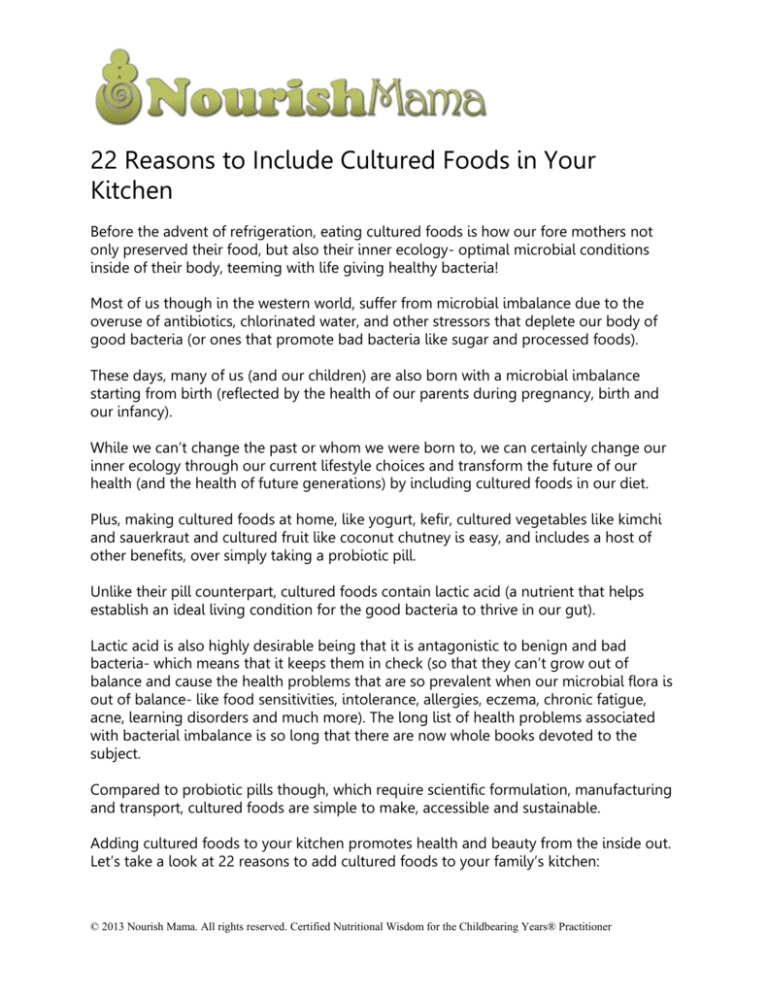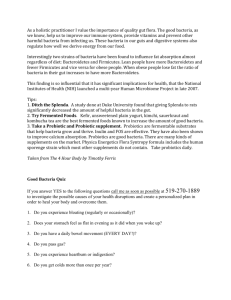
22 Reasons to Include Cultured Foods in Your
Kitchen
Before the advent of refrigeration, eating cultured foods is how our fore mothers not
only preserved their food, but also their inner ecology- optimal microbial conditions
inside of their body, teeming with life giving healthy bacteria!
Most of us though in the western world, suffer from microbial imbalance due to the
overuse of antibiotics, chlorinated water, and other stressors that deplete our body of
good bacteria (or ones that promote bad bacteria like sugar and processed foods).
These days, many of us (and our children) are also born with a microbial imbalance
starting from birth (reflected by the health of our parents during pregnancy, birth and
our infancy).
While we can’t change the past or whom we were born to, we can certainly change our
inner ecology through our current lifestyle choices and transform the future of our
health (and the health of future generations) by including cultured foods in our diet.
Plus, making cultured foods at home, like yogurt, kefir, cultured vegetables like kimchi
and sauerkraut and cultured fruit like coconut chutney is easy, and includes a host of
other benefits, over simply taking a probiotic pill.
Unlike their pill counterpart, cultured foods contain lactic acid (a nutrient that helps
establish an ideal living condition for the good bacteria to thrive in our gut).
Lactic acid is also highly desirable being that it is antagonistic to benign and bad
bacteria- which means that it keeps them in check (so that they can’t grow out of
balance and cause the health problems that are so prevalent when our microbial flora is
out of balance- like food sensitivities, intolerance, allergies, eczema, chronic fatigue,
acne, learning disorders and much more). The long list of health problems associated
with bacterial imbalance is so long that there are now whole books devoted to the
subject.
Compared to probiotic pills though, which require scientific formulation, manufacturing
and transport, cultured foods are simple to make, accessible and sustainable.
Adding cultured foods to your kitchen promotes health and beauty from the inside out.
Let’s take a look at 22 reasons to add cultured foods to your family’s kitchen:
© 2013 Nourish Mama. All rights reserved. Certified Nutritional Wisdom for the Childbearing Years® Practitioner
1) Delicious and Satisfying
2) Boost our digestion
3) Good bacteria act as the frontline of our immune system
4)The sour flavour, diminishes sugar cravigs…no willpower necessary!
5)Ferments are cheaper, more effective and more nutritious than probiotic pills. Eating
fermented condiments is one of the ways that our ancestors cultivated and sustained
proper microflora ratios!
6)Ferments are not just a source of good bacteria, but they are also a source of lactic
acid (which creates ideal living conditions for our good bacteria and is antagonistic
to harmful bacteria). Probiotic pills are just good bacteria- they don’t come with added
nutritional value that ferments do!
7)Ferments are simple, accessible and sustainable, compared to probiotic pills, which
require scientific formulation, manufacturing and transport.
8) Raw and easy to digest snack (enzyme rich fast food)
9) Life Saving Skill (if you learn how to ferment, you can preserve your food at a
moment’s notice if need be)
10) They look so darn pretty sitting on the countertop when you make them at home!
The whole house comes alive with those little beneficial bacteria babies! Making
ferments is such a lovely way to bring nature inside, all year round!
11) They increase nutrient assimilation and help with the digestion of fats, proteins and
carbs (aiding in the fullest digestion possible of all of the food we consume)
12) Help us manufacture and assimilate B complex vitamins (boost energy)
13) They ontrol optimal the ph level in the intestinal tract
14) There is some evidence that that lactobacilli may create omega-3 fatty acids
(referenced by Sandor Katz in Wild Fermentation)
15) Good bacteria are alchemists: they remove toxins from food such as phytic acid,
nitrates, oxalic acid metals, chems etc.
© 2013 Nourish Mama. All rights reserved. Certified Nutritional Wisdom for the Childbearing Years® Practitioner
16) Sometimes they transform them into more useful substances! Biologically transmute
minerals eg: silica into calcium
17) They increase the nutrient content of the foods they ferment while making the
foods more digestible (they act like a stomach outside our stomach ie: cabbage –
increases Vitamin C content by 100’s of times
18) They can transform putrefactive proteins back into amino acids
19) They inhibits the growth of diarrhea related bacteria such as shigella, salmonella and
E.coli and decreases our susceptibility to them
20 )They can clean up oil spills without imposing any toxicity to animals or the
environment!
After the Exxon Valdez oil spill, 11 million gallons of crude oil threatened the ecosystem
of Prince William Sound in Alaska.
To help clean up the disaster, scientists used microorganisms that converted the
hazardous oil into less toxic compounds.
This natural process, called biodegradation, happens when microbes like bacteria
and fungi break down complex pollutants into simpler substances to gain energy
and nutrients. In effect, the bacteria "eat" the harmful pollutants.
Bacteria can even "eat up" pollutants like radioactive materials, pesticides, metals, and
industrial solvents.1
http://bodyecology.com/articles/microbes_clean_toxic_waste.php
21) They cleanses OUR organs and tissues (clear beautiful skin!)
22) Produce cancer and tumour suppressing compounds
© 2013 Nourish Mama. All rights reserved. Certified Nutritional Wisdom for the Childbearing Years® Practitioner
Commercial Sources of Cultured Foods
Dairy:
□ non homogenized full fat plain yogurt (Saugeen or Jerseyland)
□ non homogenized full fat kefir milk www.pinehedge.com
□ raw cheese (health food stores and organic food stores)
Vegetable Based:
□ Bubbies brand naturally fermented pickles/sauerkraut
□ Kartheins’ saurkraut (made in BC) or Caldwell`s
□ unpasteurized apple cider vinegar (like Bragg’s or Omega Nutrition)
□ other unpasteurized sauerkraut
Grain Based:
□ unpasteurized miso
□Traditionally brewed tamari
□ Integrity Spelt Desem or other naturally leavened SOURDOUGH Bread (not live
bacteria, but provides metabolic by-products that nourish beneficial flora).
Blend of Symbiotic Bacteria and Yeast:
□ GT’s Kombucha- this is a drink that is naturally carbonated. It’s a great choice. You will
see it says RAW on the label.
Not available in most stores but can be ordered online:
1) Mi-Vitality (liquid probiotic) Mionegroup.com
2) In-Liven (fermented greens drink) Mionegroup.com
3) Grainfields (liquid probiotic)-many health food stores carry it.
4) Fermented Greens and Liquids by BodyEcology.com
5) Probiotic Dressings, Relishes, Salsa and Drinks by Zukay.com
Optional but recommended:
1) Quality probiotic supplement (the more strains the better): eg. Gutpro or MegaFlora
by MegaFood.com
*Hint: If all you can get your hands on is probiotic pills then add a splash or two of
apple cider vinegar to the water when you swallow it to provide a food source for the
good bacteria!
© 2013 Nourish Mama. All rights reserved. Certified Nutritional Wisdom for the Childbearing Years® Practitioner
Hints and Tips for Getting Cultured Veggies Into
Your Diet
Exploring all the ways to eat cultured foods besides having them on the side of pretty
much any savory meal that you enjoy!
Breakfast:
1) Traditional Egg breakfast with cultured veggies on the side.
2) Smoothie with Kombicha (instead of juice or water for the liquid portion).
3) Warm miso soup with cultured veggies and fresh green onion stirred in.
4) Avokraut (sauerkraut mixed with ripe avocadoes with salt and pepper on top)!
5) Refried Rice with vegetables (like shredded carrot, green onion and garlic) plus
cultured veggies on the side.
6) Heuvos Rancheros with cultured veggies on the side
7) Potatoe Pancakes with cultured veggies on the side
Lunch:
1) Pickles in sandwiches
2) Grilled cheese sandwiches with fermented ketchup and pickle
3) Crème Fraiche or yogurt in soup
4) Salad with cultured veggies on top
5) Homemade salad dressings and using the juice from cultured veggies or kombucha
6) Avokraut salad
7) Fermented coleslaw
8) Chicken salad
© 2013 Nourish Mama. All rights reserved. Certified Nutritional Wisdom for the Childbearing Years® Practitioner
9) Tuna salad
10) Sushi
Supper:
1) Put it in soup
2) Throw in a stir fry at the last moment
3) Dragon bowl (rice, greens and fermented veggies with tahini sauce on top)
4) Stir into stew
5) Lightly sauté last minute in a stir fry
6) Finely chop and mix in with cooked grains
7) On the side of rice and lentils
Other:
Use leftover probiotic juices (instead of water) to make dips, sauces or dressing.
© 2013 Nourish Mama. All rights reserved. Certified Nutritional Wisdom for the Childbearing Years® Practitioner
8 Reasons Cultured Foods Should Be a Forever Food
Group
Ever wonder how it impacts our health when we don`t heal the gut lining (leaky gut) and
restore our inner ecosystem (balance of good bacteria)?
1) Without adequate gut flora we become malnourished no matter how healthy our
food choices.
2) The result is that the leaky gut absorbs things it shouldn’t like undigested food and
doesn’t absorb what it should like: B12, Vit. A, D, E & K, protein
3) People with abnormal gut flora have deficiencies in physiological strains of e.coli that
produce the vitamins: K, B1, B2, B6 and B12. Other strains of beneficial bacteria produce
B3 and various amino acids.
4) Fibre cannot be digested and in fact it is the bacterial action on fibre that gives us the
healthy benefits of the fibre itself.
5) People with abnormal gut flora have various stages of anemia because not only can
they not absorb essential nutrients needed by the blood, but their own internal
manufacturing of these nutrients is inadequate.
6) They also have too much iron loving pathogenic flora in their gut that uses up the
iron they consume in their diets –taking iron supplements only compounds the
problem.
7) Protein deficiency- A healthy intestinal tract absorbs only proteins that have been
broken down into amino acids (enterocytes produce enzymes that break down proteins
and carbohydrates).
8) Immune deficiency- Healthy intestinal tracts also produces secretory IgA (an antibody
that neutralizes invaders and prevents them from attaching to membranes).
9) Physical barrier is broken- The bacterial layer of our digestive tract protects us from
invaders, undigested food, toxins and parasites which enter the bloodstream, causing
the immune system to launch an attack by building antibodies causing allergic and
autoimmune reactions to follow.
10) Apart from being a physical barrier, they work against invasive pathogenic microbes
by producing antibiotic like substances: anti fungal volatiles, anti viral substances
© 2013 Nourish Mama. All rights reserved. Certified Nutritional Wisdom for the Childbearing Years® Practitioner
including interferon, lizocym and surfectants that dissolve membranes of viruses and
bacteria, engaging the immune system to respond appropriately.
11) Suppresses the body’s ability to cleanse from harmful substances- our healthy gut
flora can neutralize nitrates, indoles, phenols, skatol, and many other toxic substances as
well as inactivating histamine and chelating heavy metals and other poisons.
12) Good bacteria can also absorb carcinogenic substances- making them inactive
while suppressing hyperplastic processes in the gut (basis of all cancer formation).
13) Chronic fatigue- Nearly every meal that a person eats when they have a leaky gut
causes some kind of systemic threat often causing chronic fatigue – the longer that the
problem goes unchecked the harder it becomes for the body to produce antibodies
(essential for immune health) and keep hormonal balance.
14) Mineral absorption is impaired (e.g. copper, iron, magnesium, selenium and zinc).
Minerals help keep the blood alkaline and stabilize our nervous system etc. People with
leaky guts are prone to anxiety.
© 2013 Nourish Mama. All rights reserved. Certified Nutritional Wisdom for the Childbearing Years® Practitioner









